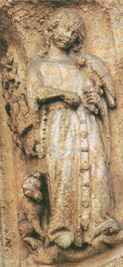Leonor de Guzman
Leonor Núñez de Guzmán (* 1310 in Seville , † 1351 in Talavera de la Reina ) was a Castilian noblewoman and the mistress of King Alfonso XI. of Castile .
Life
Leonor was the daughter of the Jewish merchant and nobleman Pedro Núñez de Guzmán Gonzales and his wife Beatriz Ponce de León y Meneses, a great-granddaughter of King Alfonso IX. from León . Her parents married Leonor to Juan de Velasco when she was a young girl.
After his death (1328), when she was barely 20, she made the acquaintance of King Alfonso XI, who was also young in Seville. This was so impressed by her beauty that he entered into a permanent liaison with her. He also preferred her to his wife Maria of Portugal , daughter of the Portuguese king Alfonso IV , whom he married for political reasons in 1328. After Mary had given birth to the heir to the throne, who would later become Peter I the Cruel (1334), Alfonso XI left. she completely and from then on only lived with Leonor. The humiliated rightful queen resented her unfaithful husband for the publicly displayed favor of his lover. The king gave Leonor plenty of presents, for example with the lords of Huelva , Tordesillas , Medina-Sidonia and the like. a. He also set up her own court for her in Seville and often listened to her advice on political issues. Through a plot by the Infante Juan Manuel, in which Leonor was also involved, the legitimate wife of Alfonso XI. are finally violated. As a result, even the Pope interfered in this affair and military clashes with Portugal broke out.
After the death of her lover, the king, who died of the plague during the siege of Gibraltar (March 27, 1350), Leonor was persecuted by Queen Mary's widow, thirsting for revenge, and her son Peter I, who was now on the throne . First, Leonor, Alfons XI. had accompanied to Gibraltar, as a grieving widow took part in the funeral procession of the dead king to Seville, but did not enter this city for fear of being arrested, since Mary and her son were there. Instead, she went to the well-fortified and owned city of Medina-Sidonia ( Andalusia ). But even there she did not feel safe and yet went to Seville in the hope of being treated graciously by Peter I. But the latter had her imprisoned. Initially interned in the castle of Seville, Leonor was allowed to receive her friends and especially her son Heinrich von Trastamara . Fearing that Leonor's supporters might overthrow her son, Maria finally had her former rival carried away to Talavera de la Reina and soon afterwards executed by the governor of Toledo , Olmeida (1351). Some researchers look for the reason for this execution in Maria's hatred, others take the uprising of Leonor's sons Heinrich and Tello against King Peter I as the cause. In the following years the power struggle between the rival stepbrothers continued and ended in 1369 with Peter's assassination and the accession of Leonor's son as Henry II.
Overall, Leonor and King Alfonso XI. ten children:
- Pedro, Lord of Aguilar (* 1330; † 1338).
- Juana, mistress of Trastamara (* 1330; † 1375).
- Sancho, Lord of Ledesma (* 1331; † 1343).
- Henry II , King of Castile (* 1334; † 1379).
- Fadrique, Grand Master of the Order of Santiago and Lord of Haro (* 1335; † 1358).
- Fernando, Lord of Ledesma (* 1336; † 1342)
- Tello , Lord of Aguilar de Campoo and, through marriage, Lord of Lara and Vizcaya (* 1337; † 1370)
- Juan, Lord of Badajoz and Jerez de la Frontera (* 1341; † 1359).
- Sancho, Count of Alburquerque (* 1342; † 1375).
- Pedro (* 1345; † 1359).
literature
- Kendall W. Brown: Guzman, Leonora de. In: Women in World History . Vol. 6 (2000), p. 655f.
- Peggy K. Liss: Isabel the Queen , New York: Oxford University Press (1992).
- T. Pech: Guzman, Leonora de. In: Allgemeine Encyclopädie der Wissenschaften und Künste , First Section, Vol. 98, p. 289.
- M. del Pilar Rábade Obradó: Leonor de Guzmán. In: Lexicon of the Middle Ages . Vol. 5, Col. 1895f.
| personal data | |
|---|---|
| SURNAME | Guzman, Leonor de |
| ALTERNATIVE NAMES | Leonor Núñez de Guzmán |
| BRIEF DESCRIPTION | Mistress of King Alfonso XI. of Castile |
| DATE OF BIRTH | 1310 |
| PLACE OF BIRTH | Seville |
| DATE OF DEATH | 1351 |
| Place of death | Talavera de la Reina |


